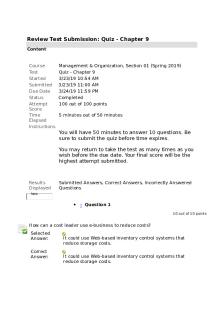Rec 100 Leisure Constraints Chapter 9 PDF

| Title | Rec 100 Leisure Constraints Chapter 9 |
|---|---|
| Course | Intro to Recreation & Leisure |
| Institution | University of Waterloo |
| Pages | 3 |
| File Size | 65.3 KB |
| File Type | |
| Total Downloads | 79 |
| Total Views | 129 |
Summary
rec 100 leisure constraints chapter 9 lecture and reading notes...
Description
Reading: Leisure Constraints Chapter 9 Monday, October 22, 2018
9:29 AM
Leisure Constraints not only influence recreation preferences but also leisure enjoyment. A common example of a leisure constraint would be your friends flopping on you. Negotiation of constraints- when people try to alleviate or overcome the influence of constraints. In these cases, participation still occurs but in a different way than the constraints had been absent. Three types of Leisure Constraints Intrapersonal Constraints- Intrapersonal – individual states, beliefs, and attributes that impact leisure preference and participation
Interpersonal Constraints- Interpersonal - arise out of social interaction with friends family and others
Structural Constraints- (costs, lack of time, other commitments, perceptions of resources available)
The purpose of Leisure Constraints Research: Studies of constraints can help to explain why observed relationships among values and attitudes, leisure preferences, and overt leisure behaviour are frequently tenuous Constraints research has assisted in generating new insights into aspects of leisure previously thought to be well-understood, such as leisure participation, motivations, satisfactions and recreational conflict. Research of leisure constraints has become a useful device to enhance communication among scholars with diverse disciplinary training. Two early assumptions of leisure constraints were
1) 2)
Constraints are immovable, static obstacles to participation The most significant effect of constraints in leisure is to block/limit participation (the absence or presence of constraints would explain why a person does or does not participate in an activity) There are 4 important themes that we can focus on to get a general sense of what Leisure Constraints are about
1)
2)
3) 4)
Research on structural Constraints (in the early research, the analysis was conducted on correlations between scores of constraints items and measures of participation and non participation, and socioeconomic/demographic variables) Alternative Measures of Constrained Leisure (a variety of other aspects of leisure have been used against which to measure the impact of constraints. These include the inability to participate at desired levels, and the insufficient enjoyment of activities) The Hierarichal Model and Negotiation of Constraints ( Research has shown that people adopto to strategies to negotiate through various levels to fulfill their leisure) The Contributions of Qualitative Research (Qualitative researchers have greatly extended the identification of the range of constraints that affect people’s leisure. More women are involved in this research as much of the work on constraints from a qualitative perspective was initially aimed at uncovering constraints that were thought to be more likely common in women. A second important contribution from qualitative researchers has been to challenge the conventional wisdom derived from the conclusions and inferences from quantitative research. The third contribution has been to provide a much clearer sense of context at both the micro (individual lives) scale and the macro scale (society) for understanding the experience and effects of constraints.
ARTICLE – How Muslim Women in The Netherlands Negotiate Discrimination During Leisure Activities Summary - Qualitative research about discrimination encountered by Muslim women in The Netherlands who are participating in leisure activities in public spaces shows
in The Netherlands who are participating in leisure activities in public spaces shows that perceived discrimination is part of everyday life. This is especially true for women who wear the veil because their visible head covering signals their “otherness” to people. The discriminatory actions encountered by women in this sample are typically of a nonviolent nature and mostly comprise unpleasant looks and negative remarks. Perceived discrimination often does not prevent the women from participating in leisure activities. Instead, they actively negotiate discrimination by applying various coping strategies, including justification, direct confrontation, accepting the discrimination, and modifying leisure behavior....
Similar Free PDFs

REC 100 - based on modules
- 26 Pages

Meanings of Leisure - RLS 100
- 6 Pages

Practica 9 - Nota: 100
- 5 Pages

Fearnville Leisure Centre
- 3 Pages

Cash+Rec - A summary
- 28 Pages

GSU Rec Site Evaluation
- 4 Pages

Constancia BAJO REC
- 1 Pages

Constraints Led Approach 1
- 3 Pages

6 Constraints of Accounting
- 5 Pages

Kinked Budget Constraints
- 5 Pages

9 - Chapter 9
- 26 Pages
Popular Institutions
- Tinajero National High School - Annex
- Politeknik Caltex Riau
- Yokohama City University
- SGT University
- University of Al-Qadisiyah
- Divine Word College of Vigan
- Techniek College Rotterdam
- Universidade de Santiago
- Universiti Teknologi MARA Cawangan Johor Kampus Pasir Gudang
- Poltekkes Kemenkes Yogyakarta
- Baguio City National High School
- Colegio san marcos
- preparatoria uno
- Centro de Bachillerato Tecnológico Industrial y de Servicios No. 107
- Dalian Maritime University
- Quang Trung Secondary School
- Colegio Tecnológico en Informática
- Corporación Regional de Educación Superior
- Grupo CEDVA
- Dar Al Uloom University
- Centro de Estudios Preuniversitarios de la Universidad Nacional de Ingeniería
- 上智大学
- Aakash International School, Nuna Majara
- San Felipe Neri Catholic School
- Kang Chiao International School - New Taipei City
- Misamis Occidental National High School
- Institución Educativa Escuela Normal Juan Ladrilleros
- Kolehiyo ng Pantukan
- Batanes State College
- Instituto Continental
- Sekolah Menengah Kejuruan Kesehatan Kaltara (Tarakan)
- Colegio de La Inmaculada Concepcion - Cebu




